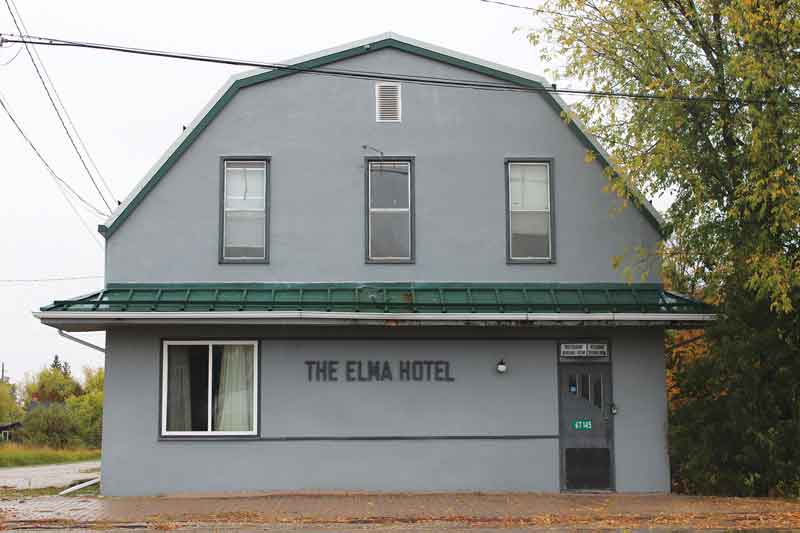The community of Elma, Manitoba was formally created by the arrival of the railway.
A December 1907 Winnipeg Tribune newspaper story notes that Winnipeg’s J. D. MacArthur, one of the largest rail contractors in the West, was making his way east from the city with a new line, a partnership between the National Transcontinental Railway and Grand Truck Pacific Railway. He had set up sidings at Dugald, Queen’s Valley and would soon reach Whitemouth and establish one called Elma.
A census of Elma’s school’s student population in 1916 tells the story of who settled the area. It had 40 Polish, 31 Ukrainian and 15 Finnish children.
For decades, Elma’s train station was the end of the line for people journeying on to other communities in the area. As a result, Elma built up a decent collection of services for a hamlet of its size. There were multiple stables, blacksmiths, sawmills, a hotel and four stores.
In 1922, the promise of the early settlement was nearly wiped out when a fire destroyed its business section. Some owners rebuilt while others left the community to find other opportunities.
Entering Elma today its signs welcome you to the home of Lidia Pajunen. The Finnish-born midwife served the region from 1907 to 1950 and traveled to her patients by canoe, horseback, or dogsled. It is believed she delivered around 2,000 babies during her career. Pajunen died in 1965 at the age of 81.
Though many of its early buildings are gone, including its train station which was demolished in 1980, there are enough structures left to help tell the story of Elma.
Elma Hotel (ca. 1928)
67145 Railway Avenue (Highway 15)
The six-room Elma Hotel was constructed circa 1928 by John Barski, replacing one that burned down in the fire of 1922. Given Elma’s status as a service centre and railway hub the hotel was always a bustling place.
The Barskis ran the hotel until 1946, though the longest-serving owners appear to be the Persons who were there from 1951 to 1973.
The hotel closed in 2007 and is currently for sale.
Elma Pool Hall (ca. 1925)
67159 Railway Avenue (Highway 15)
The pool hall was also constructed in the 1920s after the fire by Peter Kolega. At one point it boasted four billiard tables, a juke box and a lunch counter. It was a place where women could drink before they were legally able to enter beer parlours, such as the one at the hotel, starting in the late 1950s
The Kolega family lived in the large house located behind the pool hall. Intrigue about its history was created when the owner of the property in the 1990s discovered about 50 metres of concrete tunnels complete with ventilation shafts that ran from the home’s basement to various parts of the property.
Were the tunnels tied to a basement gambling enterprise or illegal alcohol production during prohibition? One town story says that wartime draft dodgers could stay at the house and under cover of night sneak out, jump on a train and disappear into the bush.
A combination of its solid construction using a variety of materials and the intrigue of the tunnels led to the pool hall and residence being designated a municipal heritage site in 2005.
Holy Cross Ukrainian Catholic Church (1909 - 1912)
104 Regan Avenue
Holy Cross was constructed between 1909 and 1912 by the community’s Ukrainian community. It replaced an earlier church and cemetery that was built before the arrival of the railway.
The building’s dome contains eight windows. In 1921, its ceiling and walls were painted with religious iconography and murals by Winnipeg artist Hnat Sych, whose work can be seen in churches throughout Manitoba and Saskatchewan.
The church still holds monthly services and maintains a small cemetery.
Elma Community Club (1953)
NW 32-10-12E
Provincial Road 406
Just south of the main townsite is the Elma Community Club which once served as its school.
The first school in the region, called Kelner School, opened in 1904. It was renamed Elma in 1918. This three-room, $35,000 replacement was opened on November 5, 1953 with the youngest student, Shirley Procevial, cutting the ribbon. The old schoolhouse was then sold and moved off-site.
In 1968, the school was part of the Agassiz School Board which began consolidating its rural schools. Elma was spared, though instead of teaching up to grade eight it would only go up to grade six. In spring 1971, it was announced that the Elma School would not reopen for the following school year.
Six months after the announcement, the building was purchased for $1 by the Elma Community Club for conversion into a hall. Work soon began remodelling the existing building to include a commercial kitchen and large cloakroom. An extension was added so that it could be used as a dance hall.
Christian writes about local history on his blog, West End Dumplings.



